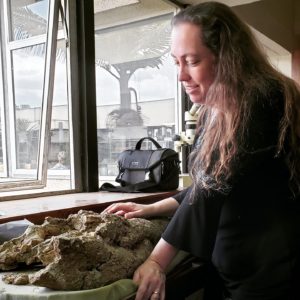Evolution of the Vertebrates
In this course, we will explore the history of vertebrates revealed by fossils and living animals. We will cover the evolution of the major vertebrate groups, including discussions of the biogeography, stratigraphy, and paleoecology of select clades. Classroom activities will include hands on projects involving fossils, casts, and skeletons.
Topics to be covered:
- What are the major vertebrate groups today and in the past?
- When did major vertebrate groups evolve?
- How did vertebrate diversity change through time?
- Mass extinctions
- Major radiations
- What were some of the key innovations during the history of the vertebrates?
- The invasion of the land
- The evolution of flight
- Secondarily aquatic and marine vertebrates
- Macropredation
Other topics include:
- Science and the scientific method
- Geologic time
- Paleontological techniques
- Human evolution
- Dinosaurs
- Phylogeny estimation
- Taphonomy
- Behavior reconstruction
- Careers in the biosciences
This class will also include a field trip to the Gray Fossil Site, a 7-4.5 million year old fossil deposit found in 2001. The site is particularly well-known for its mammal fossils, but other vertebrate groups known from the locality include fish, amphibians, and reptiles. We will be visiting the associated museum, the fossil preparation and curation laboratories, and the site itself.
Course Requirements/Examinations
- Lab assignments – 60%
- Reading discussion participation – 10%
- Research project – 30%
Daily laboratory assignments will be made available on CANVAS. Time will be provided in class for assigned activities. Group collaborations and discussions are encouraged, but each student is responsible for their own work.
Reading homework and in-class videos will be discussed in class. Participation will be tracked.
Final projects involve focused research into a clade within Vertebrata (e.g. pterosaurs, cartilaginous fish, primates). Students will work in groups of two. Research will be presented in the last week of class as a poster with associated oral presentation. Poster templates will be provided and presentation best practices will be discussed, but creativity is encouraged.
Credit Hours: 3
Course Instructors
Dr. Stephanie Drumheller-Horton, Course Director
 My research interests center on vertebrate taphonomy, ichnology, paleopathology, and paleoecology. In particular, I study bone surface modifications generated under modern and experimental conditions to better understand the processes which left similar traces on bone in the fossil record. My current research projects include:
My research interests center on vertebrate taphonomy, ichnology, paleopathology, and paleoecology. In particular, I study bone surface modifications generated under modern and experimental conditions to better understand the processes which left similar traces on bone in the fossil record. My current research projects include:
- testing methods for applying these modern analogies in a deep time perspective
- interpreting trophic interactions, behavior, and diet from bite marks left by different archosaurian groups, especially members of Crocodyliformes
- identifying and differentiating historically understudied traces and pathologies, such as bite marks vs. shell disease and different types of plant mediated damage to bone.